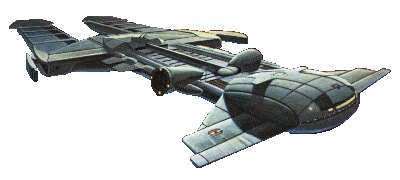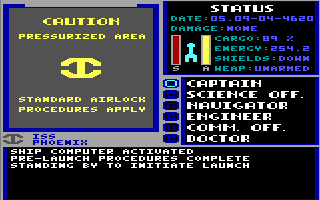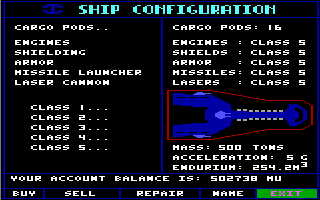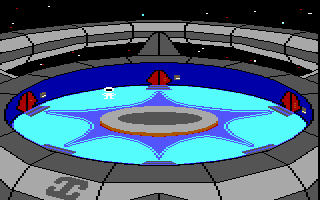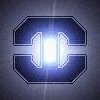
 Bones' Starflight Page
Bones' Starflight Page
![]()
Old but not forgotten...
[Last update: August 9, 2002]
[Treatise] [Story] [Software] [Links] [ProbeDemo] [EBay Search] [Space Exploration]
This site is a member of the
Starflight Web Ring
[Skip Prev]
[Prev]
[Next]
[Skip Next]
[Random]
[Next 5]
[List]
|
For one thing, Starflight was a break-through in game technology. It pushed the envelope of what was available and could commonly be done on the computers of the day. The easy to use interface, the skillful use of limited color choices, the fractal universe, and the designers' effort to keep everything in context, and the depth to the story and the back-history were some of the most important aspects that made it what it was. Let's take a look at some of these in more detail... Most of the games of the day were simplistic games. It was common for games to either be arcade-style, or have complex keyboard commands if the game was any more detailed than a simple action game. Starflight combined form and function in a way that made it easy to learn to play, and also maintained a certain aesthetic appeal that also helped to draw you into the game. Every aspect of it was kept in context, as well. When the system had a long delay due to fractal calculations, you'd be given messages such as "Entering orbit" or "Checking hull integrity". Heck, even the liscensing agreement was completely in-context to the game fiction, even if it wasn't ratified by the Gazurtoid. And when it said that unauthorized duplication could result in the destruction of the offending being, and that it would be enforced by the Interstel Corporate Police, they weren't kidding. Failure to enter the precise numbers off of the code-wheel resulted in exactly that (scanning the ships that chase you down reveals that they look like little police cars). And just when you thought there was nothing else left to be made "in-context", the group photo of the programmers/developers seemed in context, as it was taken in a cockpit, with everyone in flight-suits bearing the Interstel logo.
Other details that helped to immerse the player were minor things, such as the humor, and the "notices" section at the starbase. Seeing messages periodically appear from other ship captains gave the impression that you weren't out there alone. But where were they? Unfortunately the other ships from Arth are nowhere to be found. I think this was done on purpose to an extent, so that you still get the sense of being a lonely explorer in a vast universe. And that is a feeling that was instilled into the player very well. The universe did seem immense and empty but still interesting and wonderous (though obviously not as vast and empty as real space, which would be so boring that you wouldn't want to play). A natural extension to this would be to make a massively multiplayer game, in the same vein as games like Ultima Online, except done from the standpoint of space exploration. This is an idea that a friend and I discussed from time to time, ever since we first played Starflight, even though the technology didn't quite exist to support such a thing back then, at least not on the scale we see today.
Perhaps the CGA (and later EGA/VGA compatible) graphics adapters, depsite their pathetic nature by today's standards, actually aided the game in some way. Some of the older games, with less visuals, were actually more gripping. Why is this? Perhaps our imaginations fill in for what we can't see. Perhaps some of it was simply due to the fact that we weren't on game-overload, since there weren't as many games around, and they weren't as glitzy as that which is available today. It's hard to say.. But in any event, I've never seen a 160x200 resolution with 4 colors used so effectively, and I'm still impressed by the design of the game as a whole.
Starflight was one of the first games I ever bought with my own money (though probably not -the- first; but at any rate, $30 was a lot to me back then). I was approaching 8th grade at the time, and a friend of mine had purchased a copy and showed it to me. I was instantly intrigued, and ran out to get a copy for myself. I then played for over two weeks at about 60 hours a week (I had just gotten off from school for the summer) before I managed to win, and the only reason I managed to win that quickly was because I was being fed occasional hints from my friend with his clue book, who was playing through it simultaneously. Ever since then, it has been my desire to make something similar; to make a game that follows in Starflight's footsteps. While I still have yet to do this, I have made a demo program that was inspired by SF quite a bit. You can download it HERE (runs in DOS, and you should fully exit windows to hear the sound properly, for which you may need to install your sound-card's DOS drivers, and anyone who can't figure out how to do this doesn't deserve to play Starflight, since it was DOS only! Well, the PC version anyway). :-) More detail to come to this site... all in good time...

Starflight's fiction spans hundreds of years... Most of this is reconstructed by memory, and through use of the timeline in the game manual, so forgive any mistakes or details that may have been left out. In the beginning... or rather, at the start of the game, you're given very little background. You're briefed (in the manual) about the recent situation, about 5 ships having been launched before you and they haven't been heard from. Part of the information in the manual is the timeline you see below:
2100 - Man discovers endurium
2150 - Man discovers enduriums' application to superphotonic technology
and begins exploring. Colonization begins. Start of empire.
2300 - Man meet Velox.
2650 - Major endurium finds usher in Empire's Golden era.
2675 - Empire discovers Spemin.
2770 - Empire discovers Thrynn and Elowan.
3000 - Start of First Wave (?)
3120 - Velox pact of 3120.
3260 - First Wave (?) ends.
3400 - Start of Second Wave (?).
3450 - Project Noah is initiated.
3453 - Launch of Noah 2 expedition.
3480 - Fall of Earth.
3505 - Bomb hit Arth, creates Southern Hot Zone and forces underground
colonists above ground.
3520 - Arth society collapses and Dark Years begin.
4400 - Arth's new era begins with new council and the industrial
revolution.
4500 - Rediscovery of space flight (sublight).
4594 - Discovery of Noah 2 colony and Endurium.
4615 - First group sent out in superphotonic ships.
4620 - Present day.
At first you start out as a simple explorer, trying to make out an existence by mining within your own solar system. Once you can afford an engine upgrade and some serious fuel, you can begin exploring further into space, and find lush worlds to recommend for colonization, and eventually interact with multiple alien races, find ruins and artifacts, and little by little piece together the history of this sector of space, which goes something like this... [don't read any further if you intend to play the game from scratch, as this is one giant spoiler] A brief history... The story revolves mostly around the ancients. You pick up little tid-bits about them, but the single most important detail doesn't hit you until nearly the end of the game, but it is what explains how everything got set into motion more than a millenium earlier. Something known as the "Crystal Planet" has been moving outward in the galaxy, causing solar flares in stars along the way. These solar flares kill all life in each solar system, and as such, all space-faring races that get struck with it either perish, or have to flee. Four of the races that either exist in the game or are merely mentioned have been fleeing outward for centuries. The "First Wave" was the invasion of the Numlox and Phlegmak, who passed through long before the game takes place (though there's a high probability that they were destroyed completely). The "Second Wave" was the Uhlek and the Gazurtoid, who still exist on the map and are two of the major races you encounter in the game, but they're close to the edge of the map already. Your world has been relatively untouched since (because the noah colonies were underground and thus hard to detect), although it has become apparent that a solar flare is soon to occur in your solar system. The other major races in the game are either far enough out that they haven't been hit yet, or are also in the hot zone. You have to explore and find out what's causing the flares. Going back a ways, the history of your planet (Arth) and it's people (multiple races, including Human, Velox, Elowan, and Thrynn) is a long and arduous one. Humans created the great Star Empire, and brought these other races in on it. With the destruction of the empire, a colonization project was created to save as much of the population as possible. This was called the Noah project. Many of the Noah ships were never heard from again, but your planet was one of the original Noah colonies (Noah-2), but society falls apart and most of the technology and knowledge of Arth's history is lost soon after the southern hot zone was created. One of the clues you gain in your exploration about the fate of the Noah expeditions is that you find the old Noah-9 ship floating adrift in a planet's orbit, and also meet the Mechans, who were androids sent in ships ahead of the Noah ships to prepare planets for colonization. The Mechans were waiting for Noah-9, which never arrived, and they assume you to be that ship. Now here's the real kicker- It turns out that the ancients, this mysterious old race that no one knows much about, turns out to be Endurium, the crystals that you and every other space-faring race uses as fuel for ships. Everyone has been burning the ancients, without knowing that they were alive! The Crystal Planet is their homeworld, and they've been using it as a giant weapon to fight back against all of the technological races in the area. To save your people, you are forced to destroy the crystal planet using one of the "black egg" devices (planet-bombs, basically), thus neutralizing the threat. At this point you are allowed to continue playing the game (a good idea, especially since the game was designed mostly to be an exploration simulation), and the issue of using the ancients for fuel isn't mentioned again until Starflight 2, in which the solution is to use another substance with remarkably similar properties... Shyneum.

Lost your Starflight disks? Never fear! Download them
here: [Starflight 1], [Starflight 2],
[Starflight 1, Won + Class 5 all].
NOTE- It is illegal to download them without already owning a legal
copy of the game. This is provided as a replacement-source only. I
know you'll probably download them anyway, but that's not my responsibility.
This disclaimer is unfortunately necessary. Note that you need a 286 or
older to really play the game correctly, otherwise certain things will
happen too fast, such as the game-clock running insanely fast.
Another good source of the software, plus some useful utilities
programs is the
Starflight Source Page. Also see the links section below for
more sources of utilities, hints, cheats, etc.
You can also download my demo program here: [Probe Demo]
And someone else's interesting demo here: [Space Demo]
Additional files & resources, wholly stolen from other Starflight sites:
|
|
(many are now out of date) |
|
Bones' Space Exploration Page (my page about general armchair space exploration) Starport Central (Starflight III development) Will Parker's Starflight Page (good material here) The Starflight Fan Page (best source of info) Mac Elstrom's Starflight Page (nicely laid out) The Jova Lounge (hang out in-character) Starflight at Home of the Underdogs Starflight at Digital Press Starflight Invasion (a Starflight spin-off) |
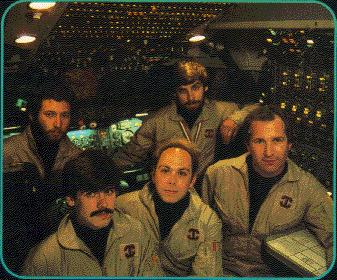 Greg Johnson, Alec Kercso, Bob Gonsalves, T.C. Lee, Rod McConnell |
This site is a member of the
Starflight Web Ring
[Skip Prev]
[Prev]
[Next]
[Skip Next]
[Random]
[Next 5]
[List]

Click here for the ultimate FREE space
simulator
(Copyright 1999, Ed T. Toton III, All Rights Reserved)
[Back to NecroBones Enterprises]
